

BUEN PROVECHO PROVECHO
A Collection of Recipes from Bon Appétit Chefs for Hispanic Heritage Month
Copyright © 2025 Bon Appétit Management Company
All rights reserved. The contents of this book are protected by copyright. Unauthorized duplication is not allowed without express written permission.
BUEN PROVECHO
Each year, from September 15 to October 15, we celebrate Hispanic Heritage Month to honor the diverse histories, cultures, and contributions of Hispanic and Latinx communities in our cafés and beyond. This year, Bon Appétit Management Company is thrilled to publish Buen Provecho: A Collection of Recipes from Bon Appétit Chefs for Hispanic Heritage Month.
“Buen provecho” means to wish someone a good meal, something that is deeply ingrained in our spirit of hospitality at Bon Appétit. Each dish featured in this cookbook has been submitted by our own team members from hispanic and latinx backgrounds.
From savory tamales and pozole to sweet empanadas and tembleque, this wide-ranging collection is filled with nostalgic family recipes, creative new inventions, and everything in between. It also offers an insightful look at the variety of rich culinary traditions and expertise our team members bring to our guests’ plates, from across Central and South America to the Caribbean and beyond.
To all of our contributors: Thank you for sharing your recipes, traditions, and stories. And to everyone reading: Buen provecho! We hope you enjoy these dishes as much as we ’ ve loved putting together this very special collection.
EXTRAS
CAMARONES EN AGUACHILE VERDE
With 25 years in the kitchen, formal training from the New England Culinary Institute, and a decade running a plant-based restaurant, Chef de Cuisine Jose Alfredo Cruz brings deep roots in Mexican food traditions to this bold, zippy South Texas take on aguachile verde.
FOR THE SHRIMP:
1 pound large raw shrimp, peeled, deveined, and butterflied
Juice of 4 limes
Juice of 1 lemon
Salt, to taste
FOR THE AGUACHILE SAUCE:
3-4 serrano chiles (or jalapeños for less heat), stemmed
1 small cucumber, peeled and chopped
1/2 cup olive oil (optional, for a creamy twist)
1/4 cup fresh cilantro (with stems)
2-3 small garlic cloves
Juice of 2 limes
Salt, to taste
Splash of cold water, to blend
FOR GARNISH AND SERVING:
1/2 red onion, thinly sliced
1 cucumber, thinly sliced or cut into half-moons
Radishes, thinly sliced (optional)
Fresh cilantro leaves
Ripe avocado slices
Tostadas, tortilla chips, or saltine crackers

Butterfly each shrimp and slice in half lengthwise so they lay flat In a glass or non-reactive bowl, toss shrimp with lime juice, lemon juice, and a generous pinch of salt
Cover and refrigerate for 20–30 minutes, until shrimp are opaque and appear “cooked.”
In a blender, combine serranos, chopped cucumber, olive oil (if using), cilantro, garlic, lime juice, and salt.
Add a splash of cold water and blend until smooth and bright green. Taste and adjust seasoning for salt and acidity it should be zippy!
(continued)
(Camarones en Aguachile Verde, continued)
Drain most of the citrus marinade from the shrimp, leaving a little for brightness. Pour the aguachile verde sauce over the shrimp. Add red onion, cucumber slices, and radishes. Mix gently and chill for 10 more minutes to let the flavors meld.
Plate with avocado slices and cilantro leaves on top. Serve with tostadas, saltine crackers, or tortilla chips and enjoy with a cold Mexican beer or Topo Chico.
Try these additional variations:
Add thin slices of mango or jicama for a sweet crunch
For a smoky twist, use charred serranos or blend in a spoonful of chipotle en adobo for a spin on aguachile rojo
For extra South Texas flair, drizzle with Valentina or Chamoy before serving
INDIO VIEJO
Born in Granada, Nicaragua, Supervisor Ena Prado honors her family’s culinary traditions through this savory stew with deep Indigenous roots that was passed down from her grandmother.
Makes 6-8 servings
FOR THE TORTILLAS
15 corn tortillas, cut into pieces
4 cups water
FOR THE BEEF
1-1/2 to 2 pounds beef eye of round roast
5 cups water
1 onion, quartered
FOR THE STEW
1/4 cup lard or vegetable oil
1 onion, diced
1 head garlic, peeled and minced
1 green pepper, diced
3 tomatoes, diced
1/2 bunch cilantro, chopped
1 bunch mint, chopped
1 lemon, juiced
1 teaspoon ground achiote (annatto) or paprika
1-1/2 teaspoons salt, or to taste

The night before, cut the tortillas into small pieces and place them in a medium bowl. Cover with water and set aside overnight, covered with a cloth. The next day, drain the tortillas and set aside
In a large soup pot, combine the beef, water, and quartered onion. Cover and simmer over medium-low heat for 2-1/2 hours or until the meat is tender. Remove the beef and shred using two forks Reserve the broth for blending the tortillas
Blend the reserved tortillas with 4 cups of the beef broth until smooth.
In a separate large pot, heat lard or vegetable oil over medium-high heat Add diced onion, garlic, and green pepper and sauté for about 5 minutes. Add tomatoes, cilantro, mint, lemon juice, achiote or paprika, and salt.
Cook for 3 minutes, then stir in the shredded beef and tortilla mixture Reduce heat and simmer for 10 minutes, stirring frequently.
Serve hot with fried plantains or crusty bread.
PORK POZOLE
Senior Cook Carlos Garcia, originally from Monterey, California, grew up cooking along the Northern West Coast and later embraced Southern cuisine after moving to Memphis, Tennessee ten years ago. His passions are gaming and travel adventures with his kids.
FOR THE PORK AND BROTH:
4-5 pounds pork butt
1/2 white onion
3-4 bay leaves
4-5 garlic cloves
Salt, to taste
Water, to cover 2 cans (or equivalent) hominy, drained
Caldo de Pollo (chicken bouillon), to taste
FOR THE CHILE DEPOSIT:
4-5 California chile pods
4-5 guajillo chile pods
1-3 tsp Mexican oregano
2-3 garlic cloves
1/4 white onion
Salt or Caldo de Pollo, to taste
FOR SERVING:
Lemon, cut into wedges
Shredded cabbage
Chopped cilantro
Chopped white onion
Sliced radishes
Corn tortillas, warmed
In a large stockpot, combine pork butt, onion, bay leaves, garlic cloves, and salt. Cover with cold water and bring to a boil Reduce heat and simmer until pork is fork-tender, about 1-1/2 hours.
While the pork cooks, prepare the chile deposit. Soak chile pods in hot water until softened. Transfer to a blender with some of the soaking liquid, then add oregano, garlic, onion, and salt or Caldo de Pollo. Blend until smooth and strain through a sieve.
Add hominy and chile deposit to the pork. Adjust seasoning with Caldo de Pollo, and simmer for an additional 10 minutes
Serve hot with lemon wedges, shredded cabbage, chopped cilantro, chopped onions, sliced radishes, and warm corn tortillas. Enjoy with a beautiful smile and an “Olé!”


GREEN CHICKEN POZOLE
Executive Chef Zulma Rodriguez Rios grew up loving her grandmother’s red pork pozole. She now shares a green chicken version inspired by her mother’s resourceful approach to cooking based on ingredients she has in the fridge. As her abuela used to say, it’s even better the next day.
FOR THE POZOLE:
1 whole chicken (about 3 pounds), cut into pieces
1 medium onion, halved
1 head of garlic, halved
4 bay leaves, divided
1 (10 pound) can hominy, rinsed
1/2 cup oil
3 jalapeño peppers (or serrano for spicier flavor)
3 poblano peppers
6 tomatillos
1 bunch cilantro
2 teaspoons Mexican oregano
Salt, to taste
FOR GARNISH AND SERVING:
Red radish, sliced
Iceberg lettuce, shredded
Lime wedges
Red onion, sliced
Sour cream
Tostadas
Avocado (optional)
In a large pot, combine the chicken, 2 bay leaves, halved onion, and halved head of garlic Cover with water and boil until chicken is tender and pulls apart Remove chicken and let cool. Set aside the chicken broth.
Preheat the oven to 375°F.
Remove the chicken meat from the bones and set aside Strain the broth, reserving the onion and garlic for blending later.
Rinse hominy in a colander until water runs clear.
In a skillet, fry the jalapeños and garlic in oil for 2–5 minutes Remove stems (and seeds if desired for less heat).
Roast tomatillos and poblano peppers at 375°F. Once roasted, place poblanos in a plastic bag to steam, then peel, deseed, and destem (continued)
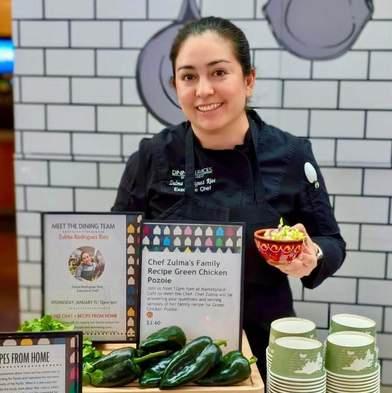
(Green Chicken Pozole, continued)
Blend the fried jalapeños, tomatillos, cilantro, reserved onion and garlic, and poblanos with the reserved chicken stock until smooth.
In a large pot, combine the rinsed hominy, remaining 2 bay leaves, oregano, and chicken stock. Ensure the liquid covers the solids and simmer. Meanwhile, prepare the toppings
Stir in the blended green mixture and shredded chicken. Season with salt and simmer for 20 more minutes.
Serve hot with your choice of toppings. Add lettuce just before serving to avoid wilting
Tip: Pozole tastes even better the next day! You can let it cool, then reheat before serving. It pairs perfectly with sour cream and corn tostadas.
POZOLE VERDE
Hourly Supervisor Irene Pena makes this comforting pozole verde for her family, and it has become a beloved favorite among relatives and friends.
5 pounds pork loin, cut into small cubes
5 pounds chicken breast, cut into small cubes
5 pounds tomatillos
10 serrano chiles
1 onion
3 bundles cilantro
3 garlic cloves
2 green peppers
3 bay leaves
Oregano, to taste
Salt, to taste

Cook tomatillos and serrano chiles in a pot until softened.
In a blender, combine the cooked tomatillos and chiles with garlic, onion, cilantro, and green peppers. Blend until smooth.
In a large pot, cook the pork loin and chicken breast with salt and bay leaves until fully cooked. Once the meat is cooked, add the blended green sauce to the pot.
Season with oregano and additional salt to taste Simmer to allow the flavors to meld before serving.
CHICKEN TORTILLA SOUP
Sous Chef Jose Lopez developed this hearty tortilla soup recipe over the years, and it remains a crowd favorite for its rich, smoky flavors.
Makes 4 servings
FOR THE CHICKEN:
1 pound chicken breast
4 tablespoons oil
1/2 tablespoon chili powder
1/2 tablespoon ground cumin
1/2 tablespoon salt
1 teaspoon garlic powder
1 teaspoon onion powder
1 teaspoon black pepper
1/2 teaspoon paprika
1/2 teaspoon coriander
FOR THE SOUP:
4 cups onion, diced
2 cups poblano pepper, diced
One 14-ounce can of tomatoes
3 garlic cloves
2 tablespoons fresh cilantro, chopped
8 ounces guajillo chiles, toasted
3 crispy corn tortillas
6 cups chicken stock

DRY SPICE MIX:
2 tablespoons paprika
1 tablespoon ground cumin
1 tablespoon onion powder
1 tablespoon garlic powder
1/2 tablespoon ground coriander
1/2 tablespoon black pepper
2 tablespoons salt
1 bay leaf
FOR GARNISH:
Pico de gallo
Queso fresco
Tortilla strips
Prepare the chicken: In a bowl, combine chicken breast with canola oil, chili powder, cumin, salt, garlic powder, onion powder, black pepper, paprika, and coriander. Marinate for 45 minutes to 1 hour
Preheat the oven to 350°F.
(continued)
(Chicken Tortilla Soup, continued)
Sear the chicken in a large pot over medium heat for 4 minutes per side, then remove and finish in a 350°F oven for 15 minutes or until the internal temperature reaches 165°F. Shred the chicken and keep warm.
Make the soup base: In the same pot, sauté the diced onion, poblano pepper, and garlic for about 4 minutes Add the canned tomatoes, cilantro, toasted guajillo chiles, and the dry spice mix Continue cooking until the vegetables are tender and most of the liquid has cooked out.
Blend and simmer: Transfer the cooked mixture to a blender, adding the toasted corn tortillas. Blend until smooth. Return the puree to the pot and stir in the chicken stock Bring the soup to a boil, then reduce heat and simmer for 15 to 20 minutes Season with salt and pepper
To serve: Ladle the soup into bowls and garnish with shredded chicken, pico de gallo, queso fresco, and tortilla strips.
TRADITIONAL DOMINICAN SANCOCHO
Cold Prep Chef Virginia Santos helped her mother in the kitchen, and this traditional Dominican sancocho is a tribute to those cherished memories.
1 tablespoon vinegar
Salt and black pepper, to taste
1 pound bone-in beef
1 pound bone-in, skinless chicken
3 garlic cloves, crushed
1 tablespoon oregano
1 onion, chopped
1 green bell pepper, chopped
1 bouillon cube
1/2 pound smoked ham
10 cups water (approximately)
2 green plantains, peeled and chopped
1 white malanga, peeled and chopped
1 yam, peeled and chopped
1 sweet potato, peeled and chopped
1/2 squash, peeled and chopped
1 corn on the cob, sliced into rounds
Fresh cilantro, chopped, for garnish
Coat the beef and chicken with vinegar and salt. Let marinate for two hours, then rinse well. Season with garlic, oregano, onion, green bell pepper, black pepper, and the bouillon cube. Let rest for at least 15 minutes.
In a large pot, sauté the beef, chicken, and smoked ham over medium heat until well seared Add water as needed and continue cooking until the meats are tender, about 1 hour or more. Add approximately 10 cups of water to the pot and bring to a boil.
Peel and chop the vegetables. Add the plantains, yam, corn, and squash first, followed by sweet potato and malanga. Simmer until tender.
To thicken the stew, remove a few pieces of cooked squash and plantain, mash them, and return them to the pot.
Taste and adjust salt and pepper as needed. Stir in chopped cilantro just before serving Serve hot, ideally with white rice, avocado, and a touch of spice if desired.


KING’S BEEF CHILI
Chef Manager Ruben Villanueva learned to cook from his mother, who passed down this chili verde recipe. He added Doritos for a fun touch!
Makes 5 servings
2-1/2 ounce onion, chopped
2-1/2 ounce bell peppers, chopped
2-1/2 ounce fresh chili peppers, chopped
2-1/2 ounce tomatillo, chopped
14 ounces ground beef (80/20 blend)
2-1/2 ounces dry pinto beans
2-1/2 cup boiling water (for beans)
4 fluid ounces beef stock
1/2 teaspoon kosher salt
2-1/2 teaspoons lime juice
1/2 teaspoon oil
1-1/4 teaspoon tomato paste
3-3/4 tablespoons brewed coffee, unsweetened
9 ounces Nacho Cheese
Doritos or other tortilla chips, crushed
Cook the pinto beans: In a small pot, combine the dry pinto beans with 1/2 cup boiling water. Lower heat to a simmer and cook until the beans are al dente. Drain and set aside.

Make the chili verde: In a sauté pan over medium heat, cook the chopped chili peppers, onion, bell peppers, and tomatillos until softened. Add the ground beef and cook thoroughly until browned.
Stir in the cooked pinto beans, beef stock, brewed coffee, and water. Simmer until the beef and beans are tender.
Add the crushed Doritos, a splash of lime juice, and kosher salt to taste Serve hot
SHRIMP AND PORK MOFONGO
General Manager Luis Colon learned how to cook from his mom. During visits to see family in Puerto Rico, mofongo was always his top request — he shares, “I could never get enough of it!”
FOR THE PLANTAINS:
3 large green plantains, sliced
1 cup oil
1 tablespoon garlic powder
1/4 teaspoon salt
1 garlic clove, chopped
14 grams beef bouillon cube, crushed
FOR THE SHRIMP:
6 ounces medium shrimp, cooked, peeled, deveined, tail on
1/8 cup fried pork skins, crushed
3 tablespoons lime juice
2 tablespoons butter
2 tablespoons garlic powder
1/2 tablespoon parsley, chopped
In a frying pan over medium heat, heat oil and cook the plantain slices for 10 minutes, flipping halfway through. Avoid overcooking, as they will become too hard. Remove from pan and blot with paper towels to remove excess oil.
In a small frying pan, cook the chopped garlic clove and crushed bouillon cube until golden brown.
In a large bowl, mash the cooked plantains with a fork Add garlic powder, salt, and the cooked garlic and bouillon mixture.

Line a small round bowl or container with plastic wrap. Press the mashed plantain mixture into the bowl until compacted. Invert onto a plate and remove plastic wrap.
For the shrimp, heat a frying pan over medium heat Melt butter and sauté the shrimp for 2 minutes. Season with garlic, lime juice, parsley, and crushed pork skins. Arrange the cooked shrimp around the molded plantains and serve.
MOFONGO
Cook Jeremy Garcia fell in love with mofongo while visiting Puerto Rico. He says, “I experienced authentic Mofongo and never looked back.” Ever since, it has been his go-to comfort food, something he brings to all kinds of gatherings, and a dish he continues to perfect with his mom.
Oil, for frying
2 green plantains, peeled and sliced into 1-inch circles
Pork rinds, crushed
3 garlic cloves
3 tablespoons olive oil
Salt, to taste
1/2 stick melted butter

In a mortar, crush the garlic, then add the melted butter and crushed pork rinds. If your mortar is too small, crush each ingredient separately and combine in a bowl.
Deep fry the plantain slices until golden and crispy, then add them to a round bowl with the garlic mixture.
Mash the plantains and garlic mixture together thoroughly.
Press the mixture into balls using the shape of the bowl. Serve with your favorite stew and garnish with cilantro.
LOS GNOCCHI DEL 29
Gnocchi of 29
Senior Cook Mariela Drewry’s recipe for “Los gnocchi del 29,” a traditional Argentine dish cooked on the 29th of each month rooted in a 19th-century custom from Italian immigrants, which symbolizes luck and prosperity.
2-1/4 pounds potatoes
1 egg
7-10 ounces flour
1 pinch salt
1 pinch black pepper
1 pinch ground nutmeg
Parmesan cheese, for serving
Sauce of choice (tomato-based or cream-based)
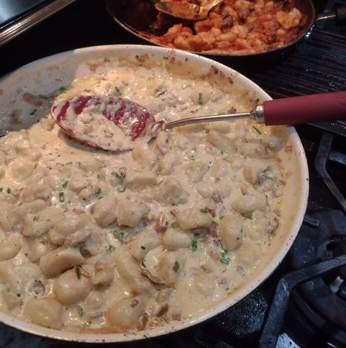
Boil the potatoes until tender, then peel and mash them Add the egg, salt, pepper, and nutmeg, followed by the flour, starting with 200 grams and adding more as needed until a soft dough forms.
Take small sections of the dough and roll into strings about 1 inch in diameter Cut the strings into 1-inch pieces.
Drop the gnocchi into boiling water and cook until they float to the surface.
Remove from the water and toss with your favorite sauce Serve topped with Parmesan cheese.
PASTELÓN DE PLÁTANO MADURO
Sweet Plantains and Picadillo Casserole
Cook Wendy Montero is from the Dominican Republic and loves to share recipes from her hometown, like this dish that she ate while growing up. This version of pastelón reflects a Dominican take on the Caribbean classic, often served with a fresh tropical salad.
6 sweet, ripe plantains
1 tablespoon butter
2 tablespoons oil
1/4 cup red onion, chopped
1/4 cup green bell pepper, chopped
1 clove garlic, minced
1 teaspoon dried oregano
2 teaspoons salt, divided
1/2 teaspoon ground black pepper
1 pound ground beef
1/2 cup tomato sauce
1 tablespoon roasted pepper-stuffed olives
1 cup water
1/2 cup mozzarella cheese, shredded
1 cup mild cheddar cheese, shredded
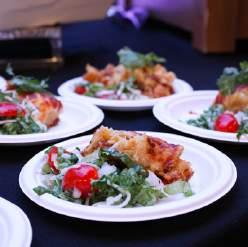

Preheat the oven to 350°F In a medium pot, boil the plantains with 1 teaspoon of salt until tender. Drain and mash the plantains until smooth, then mix in the butter and set aside.
In a medium bowl, season the ground beef with red onion, green bell pepper, garlic, oregano, 1 teaspoon of salt, and black pepper. Heat the canola oil in a medium pan over medium heat, then add the seasoned beef and cook until browned. Stir in the tomato sauce, olives, and water, and simmer until the liquid has evaporated.
To assemble the casserole, lightly butter a baking dish. Spread half of the mashed plantains across the bottom of the dish. Add all of the cooked picadillo in an even layer, then sprinkle half of the mozzarella and cheddar cheese on top.
Spread the remaining mashed plantains over the cheese, and finish with the remaining cheese Bake uncovered for 15 to 20 minutes, or until the cheese is fully melted. Serve warm.
TAQUITOS DE PAPA Y ZANAHORIA
Executive Sous Chef Omar Rocha had been cooking for over 35 years. These taquitos are just like the ones his mother used to make, which bring back memories of childhood and his early restaurant experience.
FOR THE TAQUITOS:
1 dozen corn tortillas
16 ounces oil
2 cups potatoes, peeled and boiled
1 cup carrots, boiled
1 egg
1 green onion, chopped
Salt and pepper, to taste
FOR THE TOMATO SAUCE:
4 large tomatoes, peeled and deseeded
1/2 onion, finely chopped
1 ounce garlic, chopped
1 ounce oil
1 cup water
Salt and pepper, to taste
GARNISHES:
Queso fresco, crumbled
Sour cream
Sprigs of cilantro
In a bowl, mash together the potatoes, carrots, egg, and chopped green onion to form a chunky mixture. Season with salt and pepper.
In a saucepan, heat the oil and quickly dip tortillas one at a time to soften. Remove and lay flat.
Spoon the filling into each tortilla, roll tightly into a tube, and return to the hot oil to fry until crispy. Once golden, stand taquitos upright in a colander to drain excess oil.
For the tomato sauce, heat oil in a saucepan and sauté the onion and garlic until fragrant. Add tomatoes and water, then simmer for 20 minutes. Blend until smooth and season with salt and pepper.
To serve, place three taquitos on a plate, spoon tomato sauce over them, and top with queso fresco, sour cream, and cilantro. Serve with rice and beans, and enjoy!

TAMALES DE HUITLACOCHE
Huitlacoche is a corn fungus that invades and transforms the ordinary into the extraordinary. Chef de Cuisine Jose Alfredo Cruz says to cook with it is to honor ancestral knowledge, embrace the flavors of the earth, and tell the story of corn, survival, and Mexican identity.
FOR THE MASA:
2 cups fresh masa, or 2 cups
masa harina + warm water
1/2 cup lard or vegetable
shortening
1/2 teaspoon baking powder
Salt, to taste
FOR THE FILLING:
1 tablespoon oil
1/2 white onion, chopped
1 clove garlic, minced
1-1/2 cups huitlacoche
1 poblano chile, roasted, peeled, and sliced
1-2 sprigs epazote, chopped
Salt, to taste
TO ASSEMBLE:
About 12 soaked corn husks
(hojas de maíz)
In a skillet over medium heat, sauté the onion and garlic in oil until fragrant. Add the huitlacoche, poblano chile strips, and chopped epazote Season with salt and cook until softened, about 10 minutes.
In a mixing bowl, beat the lard or shortening until fluffy. Add the masa, salt, and baking powder, and mix until smooth and spreadable. Add warm water if needed to adjust consistency.
Spread 2–3 tablespoons of masa onto each soaked corn husk. Add a spoonful of the huitlacoche filling to the center. Fold the sides of the husk inward, then fold the bottom up to enclose the filling.
Arrange tamales upright in a tamale steamer and steam for about 1 hour, or until the masa is fully cooked and pulls away easily from the husk
Serve warm with salsa roja de molcajete or a light tomato sauce. The tamales pair beautifully with refried beans and a cold agua fresca, such as hibiscus or lime-cucumber.
MUSHROOM QUESABIRRIAS
Head Chef Sebastian Warsop was inspired to create this vegetarian twist on quesabirria. With help from Executive Chef Walt Williams and Assistant General Manager Ana Flores, he substituted mushrooms for a heartier bite and debuted the dish during a Hispanic Heritage Month celebration.
FOR THE CONSOMMÉ:
2 tablespoons oil
2 tablespoons butter
2 onions, diced
6 garlic cloves, minced
2 teaspoons chili powder
1 teaspoon ancho chile powder
3 teaspoons ground cumin
1 teaspoon ground cinnamon
2 teaspoons Mexican oregano
1 tablespoon corn flour
3 chipotle peppers in adobo sauce
3 tablespoons tomato paste
4 cups vegetable broth
1 tablespoon soy sauce
2 tablespoons apple cider vinegar
FOR THE BIRRIA “MEAT”:
1 pound oyster mushrooms
2 tablespoons apple cider vinegar
2 tablespoons vegetable oil
3 teaspoons garlic powder
1 teaspoon kosher salt
FOR THE TACOS:
12 corn tortillas
1 cup vegan mozzarella shreds
Chopped cilantro, for serving
Diced onion, for serving
Lime wedges, for serving
Make the consommé: Heat the butter and oil in a medium saucepan over medium-high heat. Add the diced onion and sauté until softened. Add the garlic and cook for 1 minute.

Stir in the chili powder, ancho chile powder, cumin, cinnamon, oregano, and 1/2 teaspoon each of salt and black pepper. Cook, stirring occasionally, for 2 to 3 minutes. Add the corn flour, chipotle peppers in adobo, and tomato paste. Stir well, then add the vegetable broth and soy sauce and stir again. Bring to a simmer and cook for about 10 minutes, until slightly thickened.
Remove from heat and stir in the apple cider vinegar Blend until smooth, return to the pot, and keep warm (continued)
(Mushroom Quesabirrias, continued)
Prepare the Mushrooms: Shred the oyster mushrooms by hand into thin strips Place in a bowl and season with apple cider vinegar, oil, garlic powder, and salt. Massage to coat evenly, then cover and marinate while the consommé simmers.
Heat a large skillet over medium-high heat and add oil. Once hot, cook the marinated mushrooms in an even layer until the edges begin to crisp, about 13 to 15 minutes. Add 1-1/2 to 2 cups of the consommé and cook, stirring often, for another 5 minutes
Assemble the Tacos: In a separate pan over medium heat, add a thin layer of oil. Dip a tortilla into the consommé and place it in the pan. Add a spoonful of vegan mozzarella and a few tablespoons of mushroom mixture onto one side of the tortilla. Cook for 1 to 2 minutes until the bottom is crisp and lightly browned. Fold in half and press gently with a spatula Repeat with remaining tortillas, oil, sauce, and filling
Serve hot with chopped cilantro, diced onion, lime wedges, and remaining consommé for dipping.
SALVADOREAN PAN CON POLLO
Executive Chef Andy Herrera is a Los Angeles native with roots in El Salvador, who grew up eating Pan con Pollo during birthdays and holidays. It’s also the perfect remedy for when homesickness hits.
FOR THE CHICKEN:
3 whole chickens
2 teaspoons salt
1/3 cup yellow mustard
5 teaspoons black pepper
3 tablespoons canola oil
FOR THE SAUCE:
13 roma tomatoes
2 white onions
8 dried guajillo chiles, soaked in water
8 garlic cloves
7 whole cloves
3 teaspoons achiote
1/4 cup sesame seeds
1 cup pepita seeds
3 teaspoons ground cumin
1- 1/2 teaspoons oregano
2 teaspoons salt
3 cups water
5 bay leaves

FOR THE AIOLI:
1 cup mayonnaise
1/4 cup mustard
2 tablespoons white vinegar
1 teaspoon ground cumin
1 teaspoon black pepper
FOR ASSEMBLY AND TOPPING:
7 roma tomatoes, sliced
3 cucumbers, sliced
3 romaine lettuce heads
3 bunches watercress
20 bolillo, or torpedo rolls
Place the whole chickens in a large bowl. Add 3/4 teaspoon salt, 1/4 cup mustard, 2 teaspoons cumin, and 1/2 teaspoon black pepper Rub the marinade all over the chicken and set aside.
Heat 3 tablespoons canola oil in a large pot or Dutch oven. Brown the chicken on both sides, cooking about 3–5 minutes per side.
(continued)
(Salvadorean Pan con Pollo, continued)
To make the sauce, toast sesame seeds, pepita seeds, cumin seeds, and cloves in a dry pan. Blend with 8 Roma tomatoes, 1 white onion, soaked guajillo chilies, garlic cloves, achiote, oregano, 2 teaspoons salt, and 3 cups water until smooth.
Pour the sauce into the pot with the chicken, add bay leaves, cover, and simmer over medium heat for 1 hour
After cooking, remove the chicken from the bones and discard the bones. Return the shredded chicken to the sauce and keep covered off heat.
For the aioli, whisk together mayonnaise, mustard, white vinegar, cumin, and black pepper until smooth
To assemble, cut a slit into each roll and open them up. Spread aioli inside and line with a romaine lettuce leaf. Add chicken and sauce, then top with sliced tomatoes, cucumbers, and watercress.
REINA PEPIADA
Sous Chefs Roberto Ramirez and Geraldine Gonzalez, a husband-and-wife team at SCAD, moved to the United States from Venezuela with their son. Their Reina Pepiada recipe is a beloved dish often enjoyed for breakfast or shared with family and friends.
FOR THE AREPAS:
2 cups arepa flour
1 teaspoon fine salt
2-1/2 cups water
FOR THE CHICKEN AND AVOCADO FILLING:
21 ounces chicken breast
1 small onion, sliced
Pinch of salt
Pinch of black pepper
Water (enough to cover chicken)
2-1/2 ripe avocados
3 garlic cloves, minced
1 bell pepper, diced
1 small onion, finely chopped
1 bunch cilantro, minced
1 tablespoon mayonnaise
Juice of 1 lime
Salt and black pepper, to taste

Make the filling: Place the chicken breast, sliced onion, salt, and black pepper in a pot and cover with water by 1–2 inches. Bring to a boil, then reduce heat and simmer for 10–15 minutes until fully cooked. Remove chicken and let cool
In a large bowl, mash the avocados, then mix in garlic, bell pepper, finely chopped onion, cilantro, mayonnaise, and lime juice. Shred the cooled chicken and add it to the bowl. Season with salt and pepper to taste Cover and refrigerate until ready to use.
Make the arepas: In a large bowl, stir together arepa flour and salt. Add the water and mix until combined. Knead into a smooth dough and let rest for a few minutes Divide into 8 equal pieces, roll each into a ball, and flatten into 3.5 inch (10 centimeter) disks. Cook on a griddle or skillet over medium heat for 5–7 minutes per side, or until golden and cooked through.
To serve: Slice the arepas open and fill with generous spoonfuls of the chicken and avocado filling. Serve warm.
PATACÓN
Retail Supervisor Carmen Gonzalez loves to share her favorite dishes from the Dominican Republic, where she was born and raised. To bring a piece of her culture to campus, she added Patacón (Dominican Plantain Sandwich) to the menu at Emerson's most popular student space, the Lion's Den.
1 pound beef chuck, cut in chunks
2 teaspoons adobo (granulated garlic, onion, black pepper mix)
1 teaspoon oregano
1/2 teaspoon cumin
1/2 teaspoon salt
1/2 teaspoon black pepper
1 tablespoon oil
1 tablespoon sofrito (finely chopped bell peppers, onion, cilantro, lime juice, and garlic cloves)
4 cups strong chicken or beef stock
1 bay leaf
1 scotch bonnet pepper (optional)
1/4 teaspoon allspice (optional)
1 green plantain
Frying oil
FOR THE TOPPINGS:
Lettuce
Tomato slices
Avocado slices
Ketchup
Chipotle mayonnaise
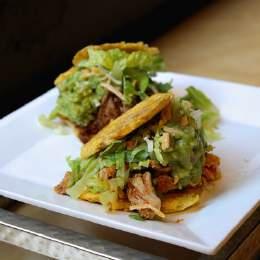
Season the beef chunks with adobo, oregano, cumin, salt, and black pepper. In a pot, heat the oil over medium heat and add the sofrito. Cook for 1 minute, until fragrant. Add the seasoned beef and sear on both sides until browned.
Pour in the stock, bay leaf, and, if using, the scotch bonnet pepper and allspice Cover and simmer until the beef is tender and easily shreds, about 1 hour. Shred the beef in the pot and drain most of the liquid, leaving just enough to keep it juicy.
To assemble the casserole, lightly butter a baking dish. Spread half of the mashed plantains across the bottom of the dish. Add all of the cooked picadillo in an even layer, then sprinkle half of the mozzarella and cheddar cheese on top. Spread the remaining mashed plantains over the cheese, and finish with the remain cheese.
Bake uncovered for 15 to 20 minutes, or until the cheese is fully melted. Serve warm.

PUPUSA WITH CURTIDO AND SALSA ROJA
Cook Kenia Tejada is from El Salvador, where she first learned to make pupusas with her family. She shared this beloved dish with the Emerson community during Hispanic Heritage Month, crafting each pupusa by hand.
FOR THE PUPUSAS:
1/4 cup + 1/3 cup oil, divided
1/2 medium white onion, halved and separated into layers
15-ounces cooked Central American red beans or red kidney beans, with liquid Kosher salt
3 cups instant corn masa flour (such as Maseca Instant Corn Masa Mix)
4 ounces grated queso Oaxaca or salted mozzarella (preferably Polly-O; about 1 cup)
FOR THE SALSA ROJA:
5 medium ripe tomatoes, quartered
1/2 medium white onion, coarsely chopped
2 serrano chiles, coarsely chopped
1 garlic clove
1/2 teaspoon kosher salt
2 tablespoons extra-virgin olive oil
FOR THE CURTIDO: (Salvadoran cabbage relish)
1/2 large head green cabbage, thinly sliced
3 medium carrots, grated on the large holes of a box grater
1/2 large white onion, thinly sliced
2 serrano chiles, thinly sliced
1 garlic clove, finely grated
2 teaspoons dried oregano, preferably Mexican
3 teaspoons kosher salt, plus more as needed
1/4 cup extra-virgin olive oil
2 teaspoons apple cider vinegar
To make the pupusas: Heat 1/4 cup of vegetable oil in a large skillet over medium-high heat. Add the onion petals and cook, tossing occasionally, until charred on all sides, about 10 to 12 minutes.
(continued)

(Pupusa with Curtido and Salsa Roja, continued)
(The oil will smoke and onions may pop use caution.) Transfer the onion to a blender, reserving the oil in the pan. Add the beans and their liquid to the blender and purée until smooth, adding up to 1/4 cup warm water if needed.
Return the onion oil to medium heat Add the bean purée and cook, stirring occasionally, until thickened to a Greek yogurt consistency, 5 to 10 minutes. Season with salt and set aside to cool.
In a stand mixer fitted with the paddle attachment (or in a large bowl), mix the masa flour, 3 teaspoons kosher salt, and 2-2/3 cups hot water on medium speed until a thick, sticky dough forms, about 1 minute Let rest uncovered for 15 minutes
Combine the cooled bean mixture with the cheese in a medium bowl. In another bowl, mix the remaining 1/3 cup oil with 1 cup warm water. Coat your hands in the oil-water mixture to prevent sticking and hydrate the dough while shaping.
Divide the dough into 12 balls (about 1/4 cup each), keeping them covered with a damp towel. Flatten one ball in your palm and use your thumb to create an indentation, forming a shallow well (it should look like half of a coconut shell). Fill with 2 tablespoons of the bean-cheese mixture, pinch to enclose, (it’s okay if some is poking out) then gently flatten into a 4 and 1/2- to 5-inch disk. Repeat with remaining dough and filling.
Heat a cast-iron skillet or griddle over medium heat. Cook each pupusa for 3 to 4 minutes per side, until puffed in the center and browned in spots. If filling leaks, scrape off the pan after cooking.
Make the curtido: In a large bowl, toss together the cabbage, carrots, onion, chiles, garlic, oregano, and 3 teaspoons kosher salt Let sit for 30 minutes to wilt Transfer to an airtight container, pressing firmly so the liquid rises above the vegetables. Cover tightly and let sit at room temperature, tasting daily, for at least 1 day and up to 5 days.
(continued)
(Pupusa with Curtido and Salsa Roja, continued)
Just before serving, drizzle with olive oil and toss to combine. Season with vinegar and additional salt if needed. (If fermenting for 48 hours or more, it may already be tangy enough.)
Make the salsa roja: Blend the tomatoes, onion, chiles, garlic, and salt until smooth. Heat the olive oil in a large skillet over medium heat, then carefully add the blended tomato mixture. Cook, stirring occasionally, until thickened and darker in color, about 20 to 30 minutes. Let cool.
Serve the bean and cheese pupusas with the curtido and salsa roja on the side.
PERUVIAN LOMO SALTADO
Director of Operations Richard Vega draws inspiration to make traditional Peruvian dishes from his time working at a Peruvian restaurant and competitive cook-offs with his father-in-law.
Makes 4 servings
1 (16-ounce) package frozen french fries
3 tablespoons vegetable oil, divided
1 pound beef tenderloin tips,
sliced 1/8 to 1/4 inch thick
Salt and pepper, to taste
1 large onion, sliced into strips
3 large tomatoes, peeled, seeded, and sliced into strips
1 yellow chile pepper
(preferably Peruvian ají amarillo), sliced
1/4 cup distilled red vinegar
Dash of soy sauce, to taste
2 tablespoons fresh cilantro, chopped
Steamed white rice, for serving

Season beef tips with salt and pepper and coat with 1 tablespoon of vegetable oil. Meanwhile, heat the remaining 2 tablespoons of oil in a frying pan over medium-high heat. Sear the beef until just cooked and juices release, then transfer to a plate using a slotted spoon
In the same pan, cook onions in the beef drippings until translucent, about 3–4 minutes. Add tomatoes and Peruvian ají amarillo; cook until tomatoes begin to soften Stir in vinegar and soy sauce, adjusting seasoning to taste.
Return beef to the pan, cover, and cook until heated through, about 3 minutes. While the beef is cooking, fry French fries until golden brown and set aside on a paper towel-lined plate.
To serve, plate a portion of steamed white rice, layer fries alongside, and top with the beef stir-fry. Garnish with chopped cilantro Enjoy!
POLLO ALLA BRASA
Sous Chef Jeanette Rodriguez, a Los Angeles native with family roots in Jalisco, Mexico, shares the dish her mother made most often: grilled chicken, roasted potatoes, and a fresh cucumber salad. She shares, “It was humble, affordable, and perfect for feeding a big family. That’s the magic of my mother — she could turn simple ingredients into something unforgettable.”
FOR THE POLLO ALLA BRASA:
5 ounce onion
2-1/2 ounce garlic clove
2-1/2 ounce yellow
chile paste (Ají Amarillo)
1-1/4 teaspoon lowsodium soy sauce
1-1/4 teaspoon chili sauce (Sambal Oelek)
0.1 grams kosher salt
0.1 grams chili powder
0.1 grams dried Mexican
oregano
1 whole chicken (or quarter legs)
FOR THE ENSALADA DE PEPINO:
1-1/2 ounces cucumber
1/4 ounce onion
1/4 ounce fresh cilantro
1/4 ounce fresh chile peppers
1-1/4 teaspoons lime juice
1/8 teaspoon kosher salt
1/8 ounce radish
3/4 ounce iceberg lettuce
FOR THE ROASTED ROSEMARY POTATOES:
3-1/2 Yukon potatoes, cut into 1-inch cubes
1/8 ounce fresh garlic
1/8 ounce fresh rosemary
1/8 ounce kosher salt
1/2 teaspoon oil
For the chicken: Blend onion, garlic, yellow chile paste, soy sauce, chili sauce, salt, chili powder, and oregano into a thick, spicy paste Rub the paste onto the chicken and arrange on a roasting pan Roast until the chicken reaches an internal temperature of 170°F Glaze with remaining pan jus and hold until ready to serve
For the potatoes: Toss cubed potatoes with garlic, rosemary, salt, and oil Spread on a sheet tray and roast at 350°F until golden brown and fork-tender, about 35 minutes
For the salad: Slice cucumber using a mandolin Combine with onion, cilantro, chile peppers, lime juice, salt, radish, and iceberg lettuce Toss and serve chilled
FAJITA SPICED FLANK STEAK
Executive Chef Rolando Campa has been with Bon Appétit for eight years. He first learned to make a fajita spice blend as a cook at Las Colinas Country Club. It’s perfect for adding bold Mexican flair to everything from vegetables to proteins, like this flank steak. It’s perfect on its own or served over salad with chimichurri or salsa ají verde. (See recipes on page 44 and 45.)
FOR THE FLANK STEAK:
2 to 3 pounds flank steak, cleaned and trimmed
1 to 5 fluid ounces oil
1/4 ounce kosher salt
1/4 ounce coarse ground black pepper
1 ounce fajita spice (see spice blend instructions)
FOR THE FAJITA SPICE BLEND:
4 ounces ground cumin
1-1/2 ounces ground coriander
1 ounce onion powder
1 ounce garlic powder
2-1/2 ounces kosher salt
3-1/2 ounces paprika
3/4 ounce ground black pepper
1 ounce chili powder
To make the fajita spice blend, mix all ingredients in a large bowl until fully combined and the texture resembles sand. Break up any spice clumps to ensure a smooth, even blend. Label and store in an airtight container until ready to use (Yields 14 ounces.)
Preheat oven to 350°F. Coat flank steak with oil, then season with salt, black pepper, and fajita spice.
Grill or sear the steak until well marked. Transfer to a sheet pan and roast in the oven for 10 to 12 minutes, or until the internal temperature reaches 130°F for medium rare, or to desired doneness.
Let the steak rest for the same amount of time as the cook time before slicing. Serve in desired portions. Pairs well with chimichurri or salsa ají verde, located on pages 44 and 45 of this cookbook!
SEARED LAMB
Inspired by techniques Chef Manager Ruben Villanueva learned while working in fine dining under Chef Andrei Enikeev, the seared lamb is served with potato pavé, a garlic truffle crema, edamame mint pesto, and finished with a chive oil.
FOR THE LAMB:
3 ounces lamb loin chop
1/2 ounce oil
1-1/4 tablespoons kosher salt
2-1/4 teaspoons black pepper
2-1/4 teaspoons dried thyme
2-1/4 teaspoons dried rosemary
FOR THE POTATO PAVÉ:
1 ounce sweet potato, thinly sliced
2 ounces baker potato, thinly sliced
1-3/4 tablespoons heavy cream
1/8 teaspoon kosher salt
1/8 teaspoon black pepper
1/4 teaspoon unsalted butter
FOR THE CHIVE OIL:
1/4 ounce fresh chives
2-1/4 teaspoons oil
1/8 teaspoon kosher salt
1/8 teaspoon black pepper
FOR THE GARLIC TRUFFLE CREMA:
1/8 fresh garlic clove, chopped
1/8 ounce fresh parsley, chopped
1/2 teaspoon shallot, minced
1/2 ounce low-fat sour cream
1/4 ounce truffle oil
1/2 teaspoon kosher salt
1/4 teaspoon black pepper
FOR THE EDAMAME MINT PESTO:
1-1/4 ounces edamame (unsalted), shelled and cooked
1/4 ounce fresh mint, chopped
1/8 ounce fresh basil, chopped
1/8 teaspoon fresh garlic clove, minced
2 teaspoons oil
1/4 teaspoon lemon juice
1/8 teaspoon kosher salt
1/8 teaspoon black pepper
For the lamb: Preheat oven to 375°F. Rub lamb with canola oil, kosher salt, black pepper, thyme, and rosemary. Sear both sides in a hot pan until browned, then finish cooking in the oven to desired doneness.
(continued)

(Seared Lamb, continued)
For the Potato Pavé: Preheat oven to 375°F. Layer sweet and baker potatoes in a baking dish, seasoning each layer with kosher salt and black pepper and dotting with unsalted butter. Pour heavy cream over the top. Cover and bake for 45 minutes. Uncover and bake for 15 minutes more, until tender and golden brown.
For the Garlic Truffle Crema: Chop garlic and parsley In a bowl, mix all ingredients until well combined. Chill and serve cold.
For the Edamame Mint Pesto: Boil edamame, then drain and cool. Chop herbs and mince garlic. Puree edamame, herbs, garlic, olive oil, lemon juice, salt, and pepper in a food processor until smooth
For the Chive Oil: Blend chives, olive oil, salt, and pepper until smooth. Strain if desired for a clearer oil.
Serve the seared lamb with the garlic truffle crema and edamame mint pesto with the potato pavé on the side Drizzle the plate with the chive oil, and enjoy!
PUERTO RICAN TEMBLEQUE
For Pastry Chef Rosa Miranda Pichardo, tembleque is more than a dish served during Christmas celebrations: “It symbolizes joy, community, and cultural tradition.” She first learned to make it at age 14 and has continued the tradition every holiday season: “It is a way to keep my cultural roots alive and to express an important part of my personal story through cooking.”
14 ounces coconut milk
3/4 cup sugar
1/4 teaspoon salt
1/2 cup cornstarch
Pinch of ground cinnamon, for garnish

In a saucepan, combine coconut milk, sugar, and salt
Spoon 3 to 4 tablespoons of the coconut milk mixture into a small bowl and stir in the cornstarch until fully dissolved. Pour the cornstarch mixture back into the saucepan and stir to combine
Bring the mixture to a boil over medium heat, stirring constantly, and cook until smooth and thickened, about 5 minutes.
Pour the mixture into individual molds
Cover each with plastic wrap and refrigerate until cold and firm, 3 hours to 2 days.
To serve, run a thin knife around the edges of each mold and invert onto serving plates. Garnish with a pinch of cinnamon
SALVADORAN PLANTAIN EMPANADAS
This recipe is a tribute to Cook Sindy Dominguez’s grandmother. She shared, “[they are] a reminder of my grandmother’s love, and a way to keep her close through the flavors and aromas of her cooking, even though she is far away.”
FOR THE DOUGH:
4 to 5 very ripe plantains (with black skins)
1 teaspoon ground cinnamon (optional)
1 teaspoon sugar (optional, if plantains are not sweet enough)
Oil, for frying
FOR THE FILLING (CHOOSE ONE):
Sweet Custard (Leche Poleada)
2 cups milk
1/4 cup sugar
2 tablespoons cornstarch
1 teaspoon vanilla extract
Pinch of salt
Refried Beans
1 cup thick refried beans (black or red beans, mashed and cooked)

Prepare dough: Peel and cut ripe plantains into large chunks Boil in water for 15-20 minutes until soft. Drain and mash into a thick, smooth purée using a fork or food processor. Add cinnamon and sugar, if desired. Let the dough cool before handling.
To make the sweet custard filling: In a saucepan, combine the milk, sugar, cornstarch, vanilla extract, and salt. Cook over medium heat, stirring constantly, until the mixture thickens to a pudding-like consistency Let cool before using
Assemble the empanadas: Grease your hands with oil. Take a portion of plantain dough and flatten it into a thick disc. Place a spoonful of filling in the center. Gently fold and seal the edges to form an empanada
Fry: Heat oil in a pan over medium-high heat. Fry each empanada until golden brown on both sides. Transfer to paper towels to absorb excess oil.
Serve: Sprinkle with sugar if desired Best enjoyed warm, with coffee or atol (a traditional hot corn drink). (For the recipe for Atol de Elote, see page 39.)
ATOL DE ELOTE
Culinary Supervisor Victor Moraga was inspired to make this Chilean atole recipe to teach students about the cultural and culinary significance of corn in Hispanic cuisine while sharing a warm and comforting treat.
5 cups whole milk
2-1/2 cups fresh yellow
corn on the cob (3-4 cobs)
1 cinnamon stick
4-1/2 tablespoons sugar
1 teaspoon kosher salt
1 tablespoon vanilla extract
5 tablespoons cornstarch
1 cup water

Fill a large bowl with ice and cold water. Bring a large pot of water to a boil. Add the corn and cook uncovered until the kernels are slightly softened, about 8 to 10 minutes. Drain the corn in a colander and immediately transfer to the ice water to stop the cooking process. Let sit for several minutes, then drain again.
Remove the kernels from the cob using a knife and transfer to a blender Add 1 cup of water, or 1/2 cup if blending in batches, and blend until puréed. Strain the mixture into a bowl using a fine-mesh strainer and discard the solids. Run the liquid through a clean strainer once more.
Stir in the milk and transfer the mixture to a medium nonstick skillet. Cook over medium heat until the milk is heated through Stir in the sugar, vanilla extract, and salt, and bring to a gentle simmer.
Reduce the heat to low. In a small bowl, combine 1/4 cup of the hot liquid with the cornstarch and whisk until smooth. Pour the cornstarch mixture into the skillet and stir constantly until the atole begins to thicken to the desired consistency, about 5 minutes Immediately remove from heat and pour into pudding bowls, soup bowls, or cups.
CHURROS
Inspired by one of his favorite chefs, Rick Bayless, Executive Chef Rolando Campa shares these classic churros that are delicious on their own or served with chocolate, caramel, ice cream, or cajeta sauce
FOR THE CHURROS:
8 fluid ounces water
3 ounces unsalted butter
1/2 ounce granulated sugar
1/8 teaspoon salt
8 ounces all-purpose flour
3 large eggs
1/4 fluid ounce vanilla extract
16 fluid ounces oil, for frying
FOR THE CINNAMON SUGAR COATING
:
8 ounces granulated sugar
1/4 ounce ground cinnamon
In a medium bowl, mix the sugar and cinnamon for the coating. Set aside.
Pour the oil into a heavy pot and heat over medium-low until it reaches 350°F.
In a separate large pot, bring the water, butter, sugar, and salt to a rolling boil over medium-high heat Once the butter has melted, remove from heat. Stir in the flour using a wooden spoon or spatula until fully incorporated, scraping the bottom and sides of the pot. Return the pot to medium heat and cook for 30 to 60 seconds, stirring to fully combine

Transfer the dough to a stand mixer fitted with a paddle attachment or use a hand mixer. Mix on medium speed, adding the eggs one at a time and scraping the bowl after each addition
Add the vanilla extract and continue mixing until the dough is smooth, glossy, and thick enough to slowly fall from the beaters.
Fill a pastry bag fitted with a large star tip and pipe 5-inch strips of dough directly into the hot oil, frying in batches of three. Cook each batch for 90 seconds to 2 minutes, or until golden brown.
Note: Piping the dough is easier while it is still warm. Dough can also be piped ahead and frozen until ready to fry.
Remove churros with tongs and drain briefly on paper towels. While still hot, toss in cinnamon sugar coating and serve immediately.
MANGO TAJÍN PALETAS
Paletas are a Mexican staple for any occasion and season, and Executive Chef Rolando Campa began making them at Perot Café a few summers ago. These refreshing mango paletas quickly became a client favorite, offering a sweet, tangy, and lightly spicy treat perfect for warm weather.
Makes 12 paletas
3 pounds mango (about 5 to 6 mangoes), peeled, pitted, and diced (fresh preferred, but frozen works)
3 fluid ounces fresh lime juice
4 ounces sugar
2 fluid ounces water, as needed
Tajín seasoning, to taste
2 silicon popsicle molds
Dice the mango into medium pieces and place in a blender along with the lime juice and sugar. Blend until smooth.
Rinse the silicone popsicle molds with a little water, then discard the water, leaving a light coating inside.
Sprinkle Tajín into each mold, just enough to coat the sides lightly. Use more or less according to preference.
Pour the mango mixture into the molds, leaving about 1/4 to 1/2 inch of space at the top to allow for expansion.
Insert popsicle sticks and carefully transfer molds to the freezer. Freeze overnight.
Once frozen, remove paletas from the molds. Store frozen until ready to serve.
PICKLED PEPPERS
Growing up in the Bay Area in the '90s, Sous Chef Hector Sanchez fondly remembers the food scene in San Francisco, Oakland, and San José. What stood out most were the sweet and tangy pickled peppers that were served at a favorite Mexican seafood spot in Pacifica. He created his own version with just the right mix of sweet and spicy.
Makes approximately 4 cups
1 large red onion, julienned
2 habanero peppers, thinly sliced (seeds optional, for less heat)
2 jalapeño peppers, thinly sliced (seeds optional, for less heat)
2 Fresno chile peppers, thinly sliced (seeds optional, for less heat)
2 cups hot water (120°F)
2 cups apple cider vinegar
2 tablespoons salt
1-1/2 cups granulated sugar
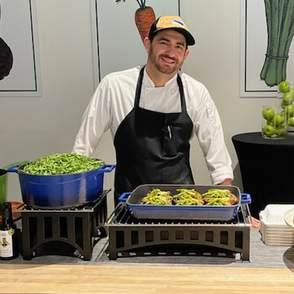
In a heatproof jar or container, combine the red onion, habanero, jalapeño, and Fresno peppers.
In a medium bowl, whisk together the hot water, apple cider vinegar, salt, and sugar until fully dissolved
Pour the pickling liquid over the vegetables, ensuring they are completely submerged.
Seal the container and let it cool to room temperature
Refrigerate for at least 1 hour before serving. For best results, allow the peppers to pickle for 24 hours.
Note: Store in the refrigerator for up to 2–3 weeks.
MANGO JELLY
Originally from Venezuela, Pasty Chef Anyi Perez Baez has been with Bon Appétit for nearly three years and brings a taste of her Caribbean heritage to this simple and delicious mango jelly. Anyi cherishes the memory of making this dessert with her grandmother, especially on days when she misses home most.
2-1/4 pounds mangoes
14 ounces granulated sugar
1 cinnamon stick


Wash the mangoes, remove the stems, and make two deep cuts in the peel. Place the mangoes in a pot with the cinnamon stick and cover with water Cook over high heat until the mangoes are soft.
Remove the water and discard the cinnamon stick. Let the mangoes cool slightly.
Peel the mangoes and extract all the pulp Pass the pulp through a juice strainer to obtain a smooth paste.
Transfer the pulp to a pot, add the sugar, and cook over medium heat for about 40 minutes, or until the mixture comes away from the bottom of the pot.
Spread the mixture into a glass or silicone mold and refrigerate for at least 5 hours or overnight before serving.
CHIMICHURRI SAUCE
Executive Chef Rolando Campa shares this vibrant and versatile chimichurri sauce, which is simple to make and perfect for pairing with fish, steak, or vegetables or used as a marinade.
Yields around 1 quart
2-1/2 ounces shallots, roughly chopped
1/4 ounce ground cumin
1/4 ounce ground coriander
1/2 ounce garlic cloves, roughly chopped
1/2 ounce kosher salt
1/4 ounce coarse ground black pepper
10 ounces parsley, roughly chopped, stems included 1/4 ounce ground paprika
8 ounces cilantro, roughly chopped, stems included
4 ounces green onion, roughly chopped
4 ounces sherry vinegar
8 fluid ounces red wine vinegar
8 fluid ounces extra-virgin olive oil
6 ounces roasted bell pepper (optional, if making a chimichurri rojo)
Place all ingredients except the olive oil in a blender or food processor. Blend while slowly streaming in the olive oil until smooth.
Season with additional salt and pepper to taste.
Label and store until needed.
SPICY SALSA AJÍ VERDE
Executive Chef Rolando Campa first discovered Salsa Ají Verde when he got married in Puerto Vallarta, where he and his wife tasted it on street tacos. Captivated by its bold, spicy flavor, he recreated it to share that unforgettable heat, “nothing a cold Mexican Coke couldn’t fix.” If you’re spice-sensitive, he recommends skipping the serrano and reducing the jalapeños by half or more.
Yields around 1 quart
6 ounces jalapeños, roughly chopped
2 ounces serrano peppers, roughly chopped
16 ounces cilantro leaves, roughly chopped
8 ounces green onions, roughly chopped
1 ounce garlic cloves, roughly chopped
4 ounces sour cream
8 ounces Greek yogurt
2-1/2 fluid ounces lime juice
2 fluid ounces olive oil
1/2 ounce kosher salt
1/4 ounce coarse ground black pepper
Combine all ingredients except the olive oil in a blender and blend until smooth. Slowly add the olive oil while blending until fully incorporated. Season with kosher salt and black pepper.
